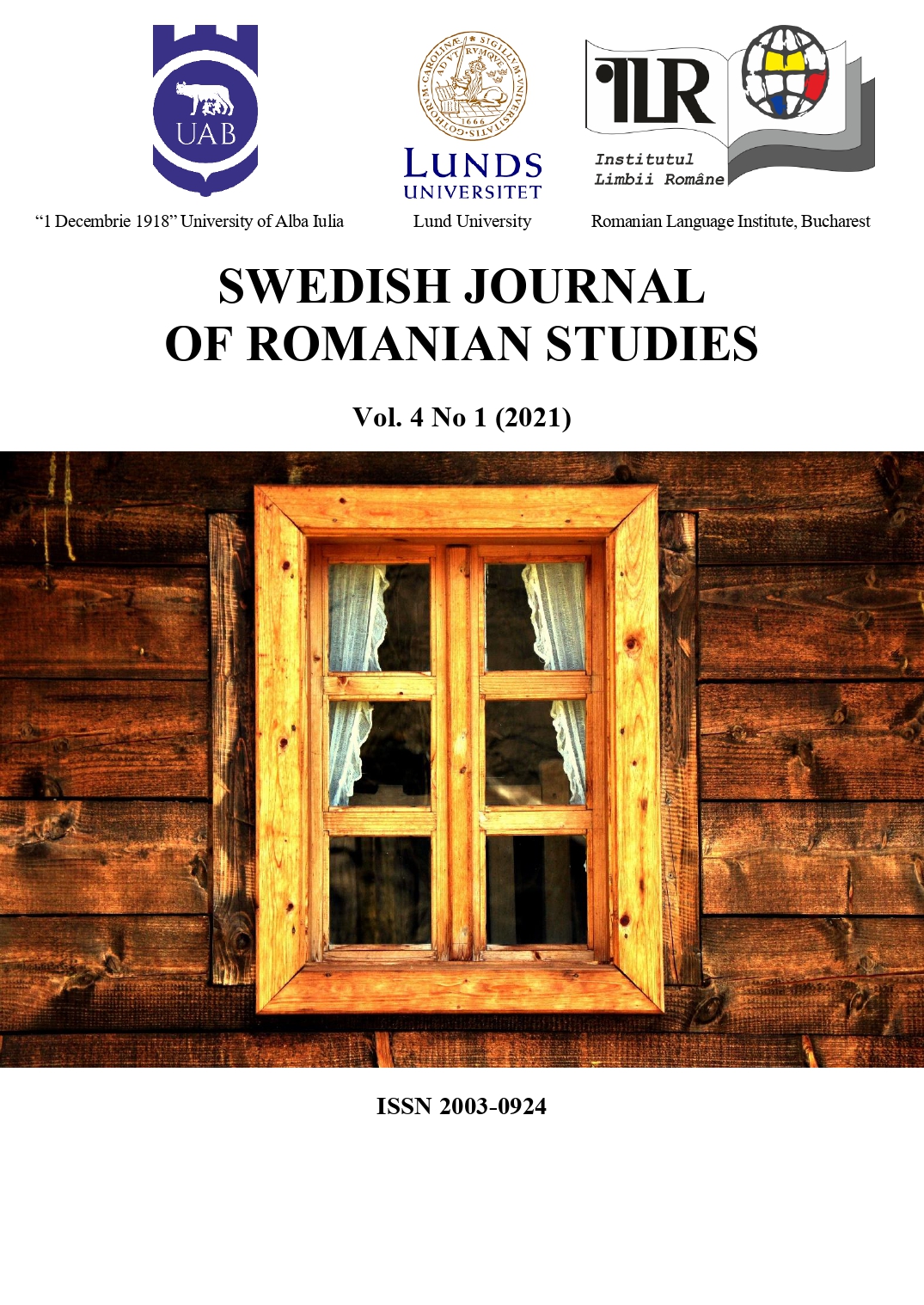„Astra. Roman epistolar” de Dito şi Idem – un caz de istorie literară
“Astra. Epistolary novel” by Dito and Idem – a case of literary history
DOI:
https://doi.org/10.35824/sjrs.v4i1.23063Keywords:
Carmen Sylva, Mite Kremnitz, „Dito und Idem, the literary collaboration, the feuilleton-novelAbstract
The literary collaboration between Carmen Sylva and Mite Kremnitz under the pseudonym “Dito und Idem” was a real accomplishment in the 19th century not only in Romania, but on the whole European continent. After a series of individual projects on translations of Romanian literature into German, Carmen Sylva and Mite Kremnitz began their literary collaboration (1882-1889). The main aim of the literary project was to promote the Romanian literature and culture in Western and Central Europe. Therefore, the project produced two epistolary novels (Aus zwei Welten, Astra) with a real success on the book market. As a result of their attainment, only one novel was translated in Romania. The epistolary novel Astra was published in 1886 in German and translated and printed in feuilleton, in Romania, the same year. Taking everything into account, the study looks into the manner in which Carmen Sylva and Mite Kremnitz managed to use literary methods characteristic to the feuilleton-novel (pickling technique, narrative “seduction”, sensational plot etc.) which assured a consistent distribution of the novel. Furthermore, the comparison between the feuilleton-format and book format of the novel Astra offered us a new perspective on the transition of translated novels into the pages of a feuilleton. All in all, the literary collaboration between Dito and Idem represents a whole page in the literary history of the Romanian novel.
References
*** (1984). Bibliografia românească modernă (1831-1918)/ Modern Romanian Biography (BRM), vol. I (A-C). București: Editura Academiei Române.
*** (2004). Dicționarul romanului românesc de la origini până în 1989 (DCRR)/ The Chronological Dictionary of the Romanian Novel from Origins to 1989. București: Editura Academiei Române.
Albérès, R-M. (1968). Istoria romanului modern/ History of the Modern Roman. București: Editura pentru Literatură Universală.
Axinte, Ș. (2011). Definițiile romanului. De la Dimitrie Cantemir la G. Călinescu/ The Definitions of the Novel. From Dimitrie Cantemir to G. Călinescu. Iași: Editura Timpul
Badea-Păun, G. (2003). Carmen Sylva. Uimitoarea Regină Elisabeta a României 1843-1916/ Carmen Sylva. The Great Queen Elisabeth of Romania 1843-1916. București: Editura Humanitas.
Bishop, C. (ed.). (2006). Participation. Cambridge: The MIT Press.
Brady, L.A. (1988). Collaborative literary writing: : Issues of authorship and authority. Ph.D. Thesis University of Minnesota. https://www.proquest.com/docview/303689285, Accesat 14 Apr. 2021.
Caracostea, D. (1943). Dinastie și creativitate/ Dynasty and creativity. în Revista Fundațiilor Regale. Omagiu Carmen Sylvei. X, no. 12, pp. 483-504.
Constantinescu, G. (2003). Confesiuni literare/ Literary confessions. București: Editura Tritonic.
Dito și Idem. (1886). Astra. Roman/ Astra. Novel. în Românul, an XXX, nr. 10 octombrie – 25 noiembrie 1886, București.
Dito și Idem. (1887). Astra. Roman/ Astra. Novel. București: Editura și Tip. Socec.
Dito and Idem. (2011). Astra. Roman Epistolar/ Astra. Epistolary novel. București: Humanitas.
Foucault, M. (1998). Aesthetics, method and epistemology. New York: The New Press.
Maiorescu, T. (1966). Critice. București: Editura pentru literatură.
Nixon, L.E. (2014). The ‘British’ Carmen Sylva: recuperating a German-Romanian writer. PhD thesis. University of Nottingham, Nottingham: ePrints www.eprints.nottingham.ac.uk/ 13946/1/Laura_Nixon_-_PhD_thesis.pdf, Accesat 10 Ian. 2021.
Pricop, Ș. (2020). Dito und Idem. Un caz de colaborare literară feminină în Belle Époque. Creația între „negociere” și „compromis”/ Dito und Idem. A Case of Feminine Literary Collaboration in Belle Époque. Between ”Negotiation” and ”Compromise”. În Philologica Jassyensia. Iași. Vol. 16. Iss. 2. pp. 189-196: https://www.ceeol.com/search/article-detail?id=920332. Accesat 10 Ian. 2021.
Stone, M.; Thompson, J. (ed.). (2006). Literary Couplings. Writing Couples, Collaborators, and the Construction of Authorship. Wisconsin: The University of Wisconsin Press.
Sylva, C. (2002). Colțul penaților mei/ From memory's shrine. vol. I, București: Vivaldi.
Ștefănescu, C. (1973). Momente ale romanului/ Moments of the novel, București: Editura Eminescu.
Tartler, G. (2011). Carmen Sylva și Mite Kremnitz între Orient și Occident/ Carmen Sylva and Mite Kremnitz between Orient and Occident. Astra. Roman Epistolar/ Astra. Epistolary novel, de Dito și Idem, București: Humanitas. pp. 7-36.
Volovici, L. (2011). Apariția scriitorului în cultura română/ The Birth of Authorship in the Romanian Culture. Iași: Editura Universității „Al. I. Cuza” Iași.
Zimmermann, S.I. (2013). Carmen Sylva – Regina poetă. Literatura în serviciul coroanei/ The Poet-Queen Carmen Sylva. Literature in the service of the crown. București: Editura ALL.
Downloads
Published
How to Cite
Issue
Section
License
Copyright (c) 2021 Lucretia Pascariu

This work is licensed under a Creative Commons Attribution-NonCommercial 4.0 International License.
Authors who publish with this journal agree to the following terms:
a. Authors retain copyright and grant the journal right of first publication with the work simultaneously licensed under a Creative Commons Attribution-NonCommercial 4.0 International License that allows others to share the work with an acknowledgement of the work's authorship and initial publication in this journal.
b. Authors are able to enter into separate, additional contractual arrangements for the non-exclusive distribution of the journal's published version of the work (e.g., post it to an institutional repository or publish it in a book), with an acknowledgement of its initial publication in this journal.
c. Authors are permitted and encouraged to post their work online (e.g., in institutional repositories or on their website) prior to and during the submission process, as it can lead to productive exchanges, as well as earlier and greater citation of published work (See The Effect of Open Access).

